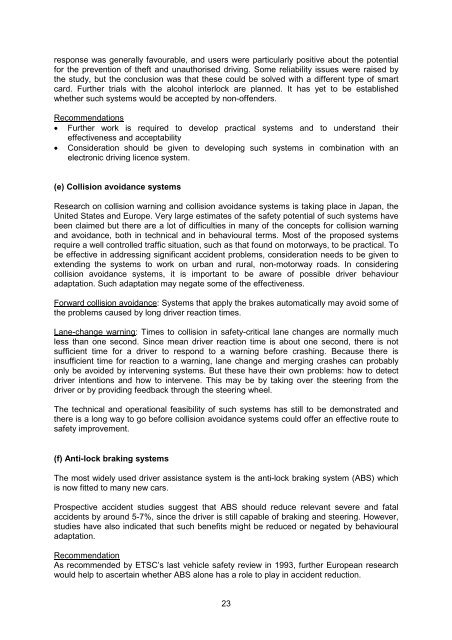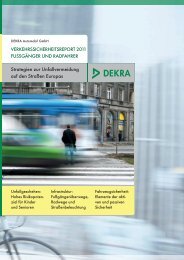PRIORITIES FOR EU MOTOR VEHICLE SAFETY DESIGN
priorities for eu motor vehicle safety design - ETSC
priorities for eu motor vehicle safety design - ETSC
Create successful ePaper yourself
Turn your PDF publications into a flip-book with our unique Google optimized e-Paper software.
esponse was generally favourable, and users were particularly positive about the potential<br />
for the prevention of theft and unauthorised driving. Some reliability issues were raised by<br />
the study, but the conclusion was that these could be solved with a different type of smart<br />
card. Further trials with the alcohol interlock are planned. It has yet to be established<br />
whether such systems would be accepted by non-offenders.<br />
Recommendations<br />
• Further work is required to develop practical systems and to understand their<br />
effectiveness and acceptability<br />
• Consideration should be given to developing such systems in combination with an<br />
electronic driving licence system.<br />
(e) Collision avoidance systems<br />
Research on collision warning and collision avoidance systems is taking place in Japan, the<br />
United States and Europe. Very large estimates of the safety potential of such systems have<br />
been claimed but there are a lot of difficulties in many of the concepts for collision warning<br />
and avoidance, both in technical and in behavioural terms. Most of the proposed systems<br />
require a well controlled traffic situation, such as that found on motorways, to be practical. To<br />
be effective in addressing significant accident problems, consideration needs to be given to<br />
extending the systems to work on urban and rural, non-motorway roads. In considering<br />
collision avoidance systems, it is important to be aware of possible driver behaviour<br />
adaptation. Such adaptation may negate some of the effectiveness.<br />
Forward collision avoidance: Systems that apply the brakes automatically may avoid some of<br />
the problems caused by long driver reaction times.<br />
Lane-change warning: Times to collision in safety-critical lane changes are normally much<br />
less than one second. Since mean driver reaction time is about one second, there is not<br />
sufficient time for a driver to respond to a warning before crashing. Because there is<br />
insufficient time for reaction to a warning, lane change and merging crashes can probably<br />
only be avoided by intervening systems. But these have their own problems: how to detect<br />
driver intentions and how to intervene. This may be by taking over the steering from the<br />
driver or by providing feedback through the steering wheel.<br />
The technical and operational feasibility of such systems has still to be demonstrated and<br />
there is a long way to go before collision avoidance systems could offer an effective route to<br />
safety improvement.<br />
(f) Anti-lock braking systems<br />
The most widely used driver assistance system is the anti-lock braking system (ABS) which<br />
is now fitted to many new cars.<br />
Prospective accident studies suggest that ABS should reduce relevant severe and fatal<br />
accidents by around 5-7%, since the driver is still capable of braking and steering. However,<br />
studies have also indicated that such benefits might be reduced or negated by behavioural<br />
adaptation.<br />
Recommendation<br />
As recommended by ETSC’s last vehicle safety review in 1993, further European research<br />
would help to ascertain whether ABS alone has a role to play in accident reduction.<br />
23



